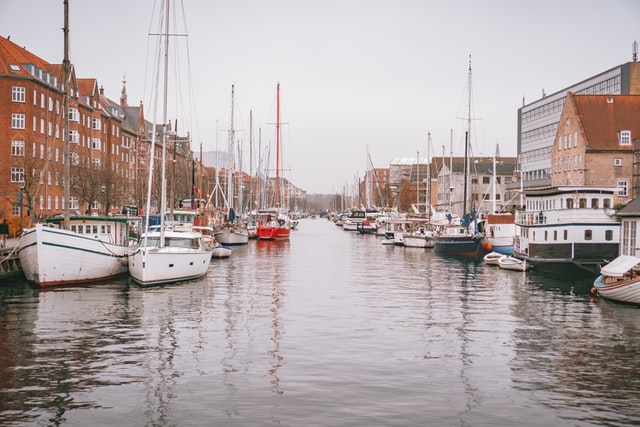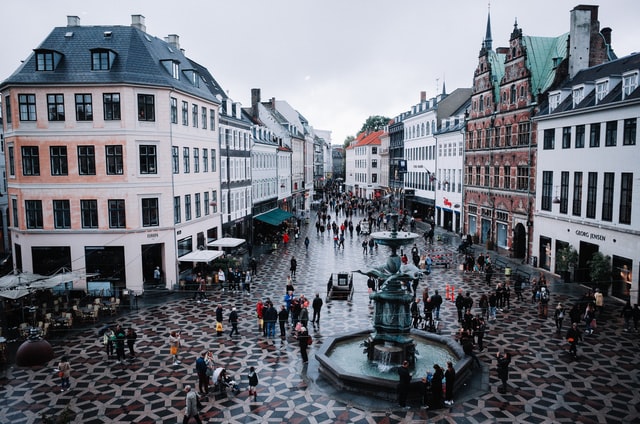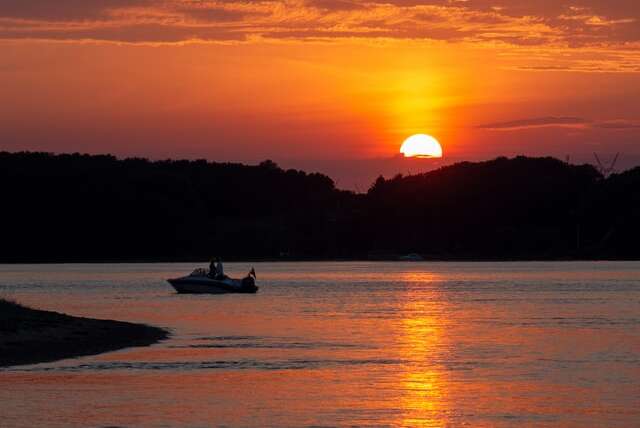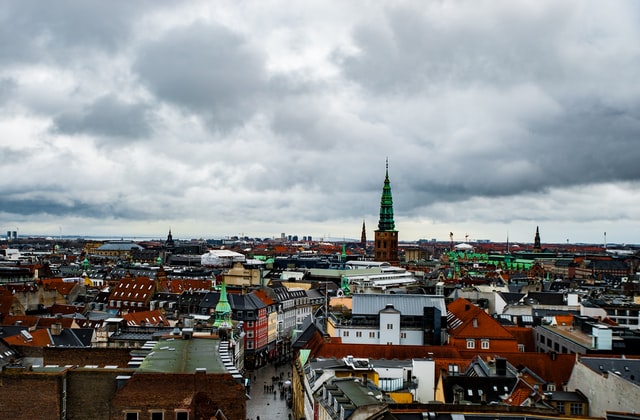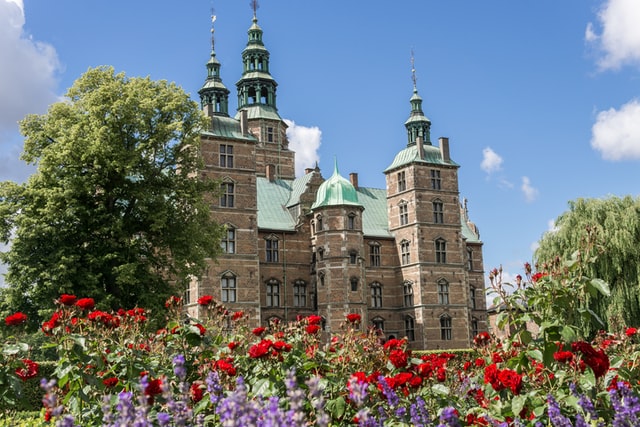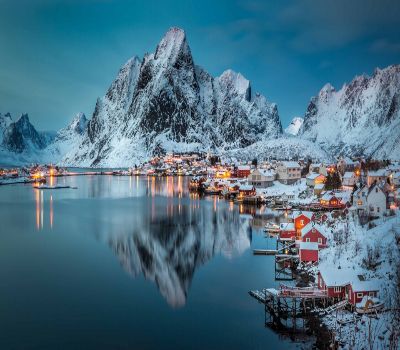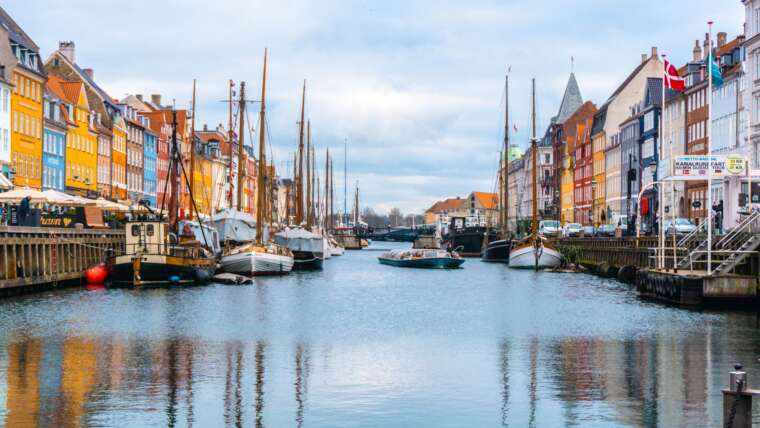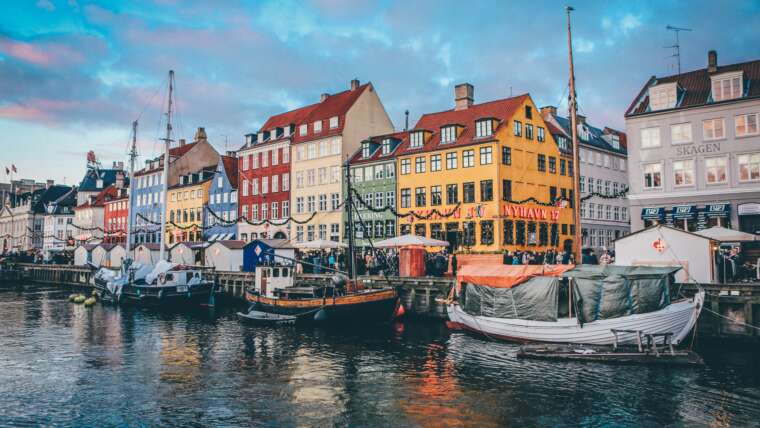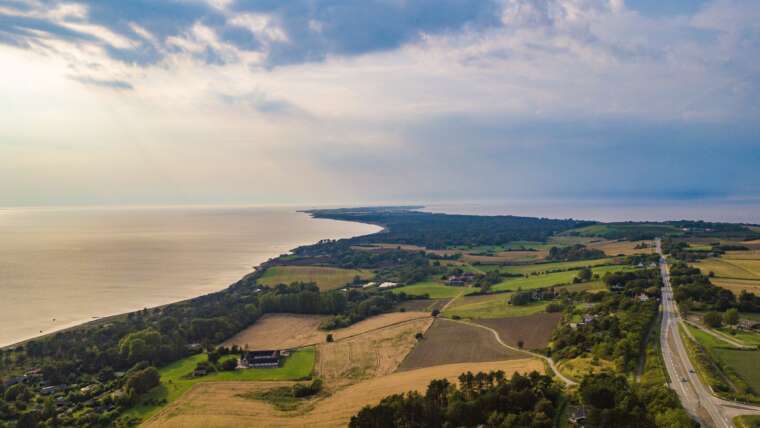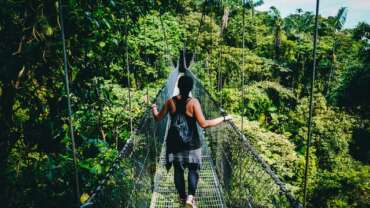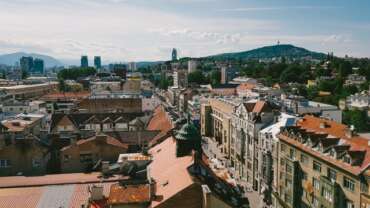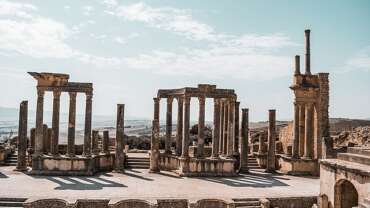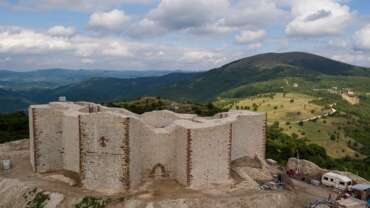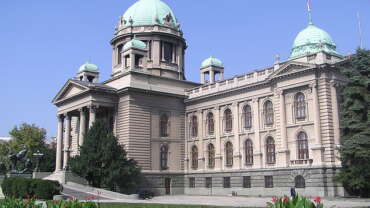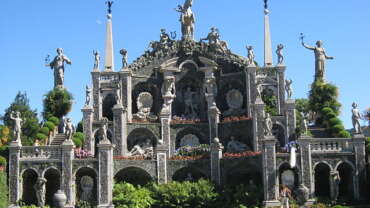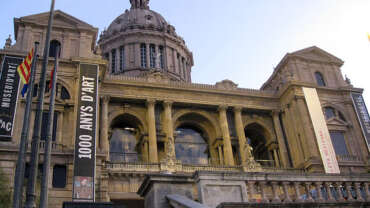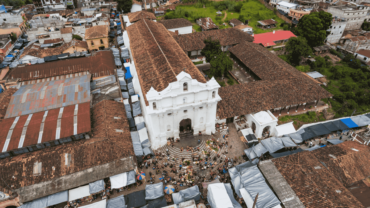Denmark - The Happiest Place on Earth
Denmark is a Scandinavian country comprising the Jutland Peninsula and numerous islands. It’s linked to nearby Sweden via the Öresund bridge. Copenhagen, its capital, is home to royal palaces and colorful Nyhavn harbor, plus the Tivoli amusement park and the iconic “Little Mermaid” statue. Odense is writer Hans Christian Andersen’s hometown, with a medieval core of cobbled streets and half-timbered houses.
It’s all about having a good time
Try out the many ways you can have fun and go green at the same time, here in Denmark – from embracing our cycling-mad culture to eating New Nordic food and swimming in our clean harbours.
Fun facts about Denmark
Can facts be funny? We seem to think so. From weird Danish traditions and letters, old flags and amusement parks to bike- and swim-friendly facts, get to know Denmark a bit better with these 17 fun facts!
1. One of the happiest countries in the world
Denmark has been named the world’s happiest country on numerous occasions, and remains to be in the very top of the UN World Happiness Report. If you want a few insider tips on how you can get a bit more happiness in your life, you should check out our guide on 12 ways you can get happy in Denmark.
2. The Danish language has no word for “please”
Don’t think we Danes are impertinent if we forget to say please when asking for a favour, we’re simply not used to use it in a sentence as there is no direct translation for “please” in Danish.
3. The oldest flag in the world
First acknowledged in 1219, the Danish flag “Dannebrog” remains the oldest state flag in the world still in use by an independent nation. Turning 800 years has never looked better – and we’ll celebrate it in true Danish birthday fashion: with a bunch of flags of course.
4. We have a word for that cosy feeling of togetherness: Hygge
Hygge is a term that goes far in illuminating the Danish soul. In essence, Hygge is about creating cosy social gatherings and intimate get-togethers with family and friends. It’s the feeling of wellbeing and warm atmospheres. You can also feel the notion of hygge in the streets of Copenhagen – literally. Walk down some the old narrow, cobbled streets, dating back several hundred years. These streets invite you to intimate walks next to colourful houses, small coffee shops and vintage boutiques.
5. Danish pastry actually origins from Vienna
In the 1840s, some Austrian bakers settled themselves in Denmark and introduced the beloved pastry. For this reason Danish pastry is actually called “wienerbrød” or “Viennese bread” in Denmark. But hey, let’s keep this well-hidden secret between us, shall we? (Because we certainly have perfected the craft of pastries.)
6. We don’t have any mountains, so biking is never uphill
Denmark is known around the world for its bike culture, and the fact that our country is quite flat is definitely an advantage in this matter. But we also have more than 12,000km of cycle tracks and lanes throughout the country which makes biking in Denmark a safe and respected way to travel. We even enjoy cycling so much that 75% continue biking all through winter and we have a Cycling Embassy.
7. More than 50% of Copenhageners cycle to and from work every day
Copenhageners cycle an average of 3km every day and this adds up to people cycling 35 times around the world every day in Copenhagen! The bicycle is clearly the preferred mode of transport in Denmark: 4 out of 10 Danes own a car but 9 out of 10 Danes own a bike. Some of us have more than one!
8. The Danish alphabet has 3 additional letters: Æ, Ø, and Å
The Danish language is said to be one of the most difficult ones to learn due to a bunch of silent letters and complex pronunciation. But we’ve added a bit more to the challenge. Let us introduce you to three letters you won’t come across in the English alphabet: Æ, Ø and Å.
9. We have some weird Danish traditions
We don’t mind admitting that some of our Danish traditions seem rather weird to the modern eye, as they include batting at a black cat in a barrel at the annual carnival “fastelavn” and burning a witch on a bonfire at Sankt Hans (midsummer’s eve). But don’t worry, we’ve toned down the craziness a bit, so nowadays the barrels are simply decorated with cut out versions of black cats and the bonfires only burn doll versions of witches.
10. You’ll find the two oldest amusement parks in the world in Denmark
If this isn’t a fun fact, we don’t know what is! Because Denmark is home to the world’s oldest amusement park, Bakken, as well as the second oldest one, Tivoli Gardens. You find Bakken located just a short 20 minute train ride from Copenhagen central station and Tivoli Gardens is located just on the opposite side of the street from the station in the centre of our vibrant capital. Both of them are brilliant suggestions if you’re looking for a fun-filled day – and that’s a fact! (okay that was cheesy but it was right for the picking…)
11. LEGO® was invented by a Dane
The world-famous LEGO® brick was invented by Danish Ole Kirk Christiansen in the town of Billund in 1949. Nowadays you can visit the original LEGOLAND® and learn more about this renowned toy at LEGO® House. We’re also proud of the fact that since 2018, LEGO’s plastic plants and other leafy pieces have been made of plants. That’s right. LEGO trees, leaves and all of those fun green elements are made from a sugarcane-based plastic.
12. Denmark has 444 islands, but only 76 of them are inhabited
This means that there are plenty of opportunities for you to go on an island getaway! Some of our favourite and most popular island retreats are the islands of Ærø, Rømø, Bornholm, and Læsø. Bornholm and Samsø were voted as the EU’s most sustainable islands back in 2020, so if you like green living, look no further.
13. You’ll never be more than 52km from the ocean in Denmark!
If you’re looking for a real challenge while you’re in Denmark, try not to see the ocean at one point. This is one challenge you’ll most likely be unable to complete as you cannot be more than 52km from the ocean in Denmark.
14. The Copenhagen harbour is clean enough to swim in
There are plenty of sandy beaches within 30 minutes of the city centre, but you can also just take a dip in harbour as the water is clean enough to swim in. You’ll find a handful of harbour baths along Copenhagen’s harbour, such as at Islands Brygge, Kalvebod Brygge, and Nordhavn. Oh and by the way, you’ll also find clean harbours in our other big cities: Aarhus, Odense and Aalborg.
15. You can drink water from the tap
Not only is our city harbours clean enough to swim in, but we are also used to drinking water from the tap. And you can enjoy this privilege as well during your stay because you’ll find some of the world’s cleanest tap water in Denmark.
16. Denmark became the first country to legalise same-sex unions in 1989
And same-sex marriage was granted in 2012. If you want to celebrate love in all its forms, you ought to join in the annual pride celebrations happening throughout the country. We’re also looking forward to hosting the World Pride event in Copenhagen in 2021.
17. There is an unofficial Danish law for “no one is better than the other”
It is called “Janteloven”, and it plays a key part of the Danish culture and mentality where everyone is accepted and equal. Janteloven is also a main reason why Danes tend to say that it goes well for us (Denmark as a whole) when for instance Nikolaj Coster-Waldau plays Jamie Lannister in Game of Thrones or Lukas Graham’s album reached No. 3 on the Billboard 200.
The happiest places in Denmark
Denmark is regularly placed at the top of the World Happiness Index for its quality of life, city planning and design with people in mind. Why is Denmark so happy? Well, take a look at some of the places that put a smile on our faces, and see if you can figure out why.
The Troll Trail
If you go down to the woods today, you’ll find more than 10 trolls ready to surprise you. It’s all part of artist Thomas Dambo’s drive to get people exploring the lesser-visited parts of Denmark.
Konditaget Lüders
This bright red playground and outdoor fitness park is in an unlikely place on the roof of one of the buildings in Copenhagen’s newest Nordhavn district, with ocean views and trampolines to enjoy.
The Infinite Bridge
This circular bridge near Aarhus is a bridge to nowhere. The only reason to visit is to enjoy the walk, soak in the sea views and enjoy the fresh air. It’s not pointless if your aim is to increase your happiness!
The Happiness Museum
The Happiness Museum in Copenhagen is a small museum ready to put a big smile on your face. Created by The Happiness Research Institute, a think tank dedicated to well-being, happiness and quality of life, it is all about what happiness is, how we measure it and what on earth living in the Nordic region has to do with it all.
LEGO House
There’s nothing like play to put a smile on your face. And at LEGO House in Billund, there is no shortage of ideas to get you playing around with LEGO. It helps that it’s at the heart of LEGOLAND® Billund Resort, a collection of fantastic family attractions, in a city that is known as the Capital of Children.
Your Rainbow Panorama
Imagine the joy of walking inside a rainbow. People in Aarhus don’t have to imagine it – they can experience it whenever they want, by walking inside Olafur Eliasson’s joyful circular walkway, Your Rainbow Panorama, on top of the ARoS Aarhus Art Museum.
The Wave
Want to ride a wave of happiness? How about live in one! In Vejle, the Wave is an apartment block with a difference – it loops up and down next to the fjord and is just another example of joyful living and design from Denmark.
WOW PARK
Have you heard of biophilia? It’s all about how being in nature makes you feel happy. So when you put biophilia together with a treetop playground, just like you’ll find at WOW PARK in Billund, that happiness multiplies.
Camp Adventure Forest Tower
We take pride in our city planning and how it is all designed with people in mind. And we also take that thinking into our countryside design, with sculptural and urban-influenced towers and developments like Camp Adventure’s Forest Tower. A walk in the woods leads to a spiral tower and views as far as Sweden – just another way that Denmark’s designs can put a smile on your face.
Facts and myths about Denmark's Vikings
We all think we know the Vikings, from the stories of raiding and plundering to Norse mythology and those horned helmets. But how much of this is fact, and how much is myth? Here’s a brief overview to help you brush up on your Viking knowledge. You’ll be ready for your own Viking adventure
Who were the Vikings?
The Vikings, or “Vikingr” in Old Norse, is the collective term used to describe the Scandinavian explorers, traders and warriors who raided, traded, explored and settled across large parts of Europe, Asia and the North Atlantic islands from around the eighth to the middle of the eleventh century.
How long did the Viking Age last?
The Viking Age lasted from the first Viking raid on the Lindisfarne monastery in Northern England in 793 to the decisive Battle of Hastings in 1066. The Viking Age had a huge impact on the medieval history of Scandinavia, Great Britain, Ireland and many other countries in Europe.
What did the Viking believe in as a religion?
The Vikings had their own belief system, Norse mythology, prior to Christianisation. Norse mythology centered on gods such as Odin, Thor, Loki and Frey. Dying in battle was the most prestigious way to depart life. This would guarantee you a seat in Valhalla, an enormous hall ruled by Odin, where fantastic banquets were held each night and preparations made to help Odin in the apocalyptic battles preceding Ragnarok (the end of the world). By the tenth and eleventh centuries, most if not all of the Norsemen had converted to Christianity, but held on to many of their pagan beliefs until late into the medieval period.
Vikings as Explorers
Vikings were feared for their famous long ships, impressive vessels that allowed Vikings not only to traverse oceans but also navigate through shallow waters and even land straight on beaches. During the Viking Age, Norsemen travelled far and wide across what was then the known world. Contrary to popular belief, Vikings did not only engage in raiding and pillaging. They were also adept traders, and established many successful settlements in England, Scotland, Ireland, Normandy and Iceland.
How Far Did The Vikings Travel?
Did you know that the first Europeans to set foot in North America were Vikings? The Vikings established a short-lived settlement in present-day Canada, under the leadership of Leif Erikson. In 845, Vikings rowed up the Seine the first time and laid siege to Paris. Demanding bribes from the city’s officials, Norsemen carried out several other attacks on Paris until a final assault in 886 ended the Vikings’ reign of terror on the city. As well as terrorising the entire North Atlantic coast, Vikings went south to North Africa and east to Russia, Constantinople and the Middle East.
What was Danegeld?
Danegeld was a tax imposed by the Vikings on the countries they raided. By paying the Danegeld, rulers could ensure that their regions would not be subject to Viking attacks. English, French and other European rulers frequently paid huge sums of silver and valuables as Danegeld to the Vikings.
What are runes and rune stones?
Vikings had their own alphabet based on the Germanic runic script, known as “futhark”. The Vikings would carve historical events into rocks using runes, now known as rune stones. The rune stones would typically detail the heroic escapades of a particular chieftain and his men or successful campaigns abroad. Much of what is known about the Vikings today stems from runic inscriptions found on stones across Scandinavia, the British isles and as far away as the Black Sea. Examples of famous runes stones can be found at the UNESCO World Heritage site at Jelling.
Viking Myths
Countless misconceptions of the Vikings exist and continue to be perpetuated today. Here are some of the more well-known Viking myths that have no grounding in historical fact:
– Vikings did not wear horned helmets. There is no evidence to suggest that they ever did, apart from in some ritual ceremonies. Having horned helmets would seriously impede your ability to fight effectively in close combat. Viking helmets were in fact conical, made from hard leather with wood and metallic reinforcement, or made in iron with a mask and chain mail. The idea of Vikings wearing horned helmets arose during the 19th century.
– Vikings were not simply savage brutes. Images of wild-haired, wild-eyed raiders are how the Vikings were mythologised. In fact, the Anglo-Danes occupying parts of Great Britain were described as excessively clean by their Anglo-Saxon neighbors, as they insisted on bathing at least once a week and kept their hair well-groomed.
– Vikings did not play the lyre.
– Vikings were not typically buried in a dolmen.
Bornholm – an island of everyday culinary heroes
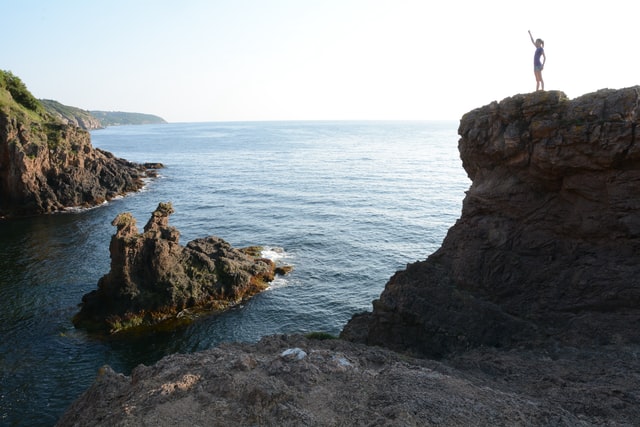
Everyone’s talking about Bornholm, until now one of our best kept secrets! The sunshine island has always drawn Danes, but now the secret’s out, more and more people are tasting Bornholm’s unique island culture.
Why you should taste island life on Bornholm
Bornholm has always been a special destination, beloved by us Danes. But the charming island nestled in the Baltic Sea has transformed from a secret spot of fishing villages and smokehouses, to a culinary destination enticing people from all across the world.





